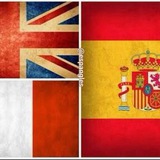#spanish #grammar
siguiente...👆
DIRECT OBJECT PRONOUNS : Part 1
✏️Read each line again. Before you do, glance at the translation beneath it. Then, read each line thinking of it as a phrase that has the same meaning as the English phrase below it.👇
la como = I eat it
(feminine DO - la sopa, la comida, etc.)
lo como = I eat it
(masculine DO - el pollo, el arroz, etc.)
la leo I read it
lo leo I read it
la veo I see it
lo veo I see it
la tengo I have it
lo tengo I have it
la compro I buy it
lo compro I buy it
✏️In the previous examples, it is clear that the subject of the sentence is "I" because the verbs are all conjugated in the "yo" form. With other verb forms, it is often desirable to add a word to clarify the subject.👇
🇪🇸 Juan la come. (la comida)
🇬🇧 Juan eats it.
🇪🇸 María lo tiene. (el libro)
🇬🇧 María has it.
🇪🇸 El chico la compra. (la pluma)
🇬🇧 The boy buys it.
🇪🇸 La chica lo ve. (el edificio)
🇬🇧 The girl sees it.
🇪🇸 Ustedes lo leen. (el periódico)
🇬🇧 You-all read it.
✏️Now, some examples of plural direct objects.👇
Juan come dos sándwiches.
Los come. or Juan los come.
María tiene tres libros.
Los tiene. or María los tiene.
El chico compra dos revistas.
Las compra. or El chico las compra.
La chica ve dos coches.
Los ve. or La chica los ve.
Ella compra dos televisores.
Los compra. or Ella los compra.
Tenemos dos mesas.
Las tenemos. or Nosotros las tenemos.
✏️Now, some examples where the direct object is a person.👇
I know you. Te conozco.
She loves him. Ella lo ama.
She loves me. Ella me ama.
Juan sees her. Juan la ve.
They call us. Ellos nos llaman.
We call them. Los llamamos.
@espangles
>>Click here to continue<<
